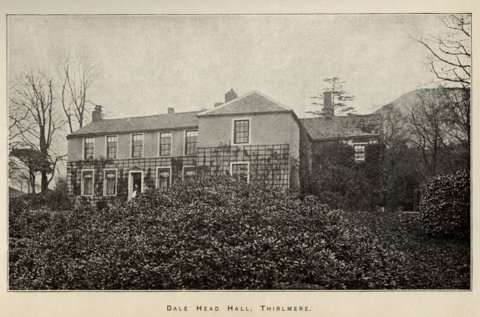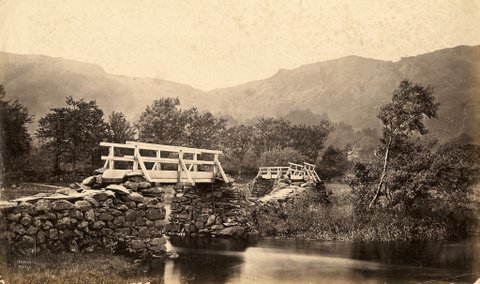Dale Head Hall
Thomas
Leathes Stanger Leathes died at Elm Bank in Lillington, Warwickshire on
June
19th 1876. He is commemorated in the stained glass window installed in
St
John’s-in-the-Vale church in 1895 by members of his family. He had not
lived
all the year round at Dale Head Hall for a long time, and the house was
largely
occupied by the servants who looked after it in his absence. His son
Henry
Stanger Leathes, a Lieutenant in the Bengal Artillery had been killed
on 29th
December 1843 at Maharjpore, in India “at
the taking of the fortress of Gwalior.”
He was buried on the battlefield, and is commemorated on a memorial in
St Mary
Abbotts Church, Kensington.
Dale
Head Hall was left to another son, George Stanger Leathes, who had
lived in
Australia for some years. He returned to England, and on the 29th
December, 1879, Dalehead Hall was sold to Manchester Corporation for
£27,250,
this being the value of the estate after assessment by two “able,
practical
Surveyors, one nominated by the Vendor and the other by the
Corporation”.

Photo
Dale Head Hall c. 1890 from “History
and Description of the Thirlmere Water Scheme” by Sir John James
Harwood, 1895.
So
Manchester acquired “all the estate
called Dalehead in the County of Cumberland with the Mansion House,
farm lands,
woods and under-woods, rights, members and appurtenances thereunto
belonging,
and also those two pieces of land covered with water forming an upper
and a
lower Lake, and known by the name of “Thirlmere” or “Leathes Water”,
the Manor
of Legburthwaite, the Mill with the yards and appurtenances, and the
plantations situate in the Vale of Saint John”.
George
did not live long to enjoy the fruits of the sale, for on July 19th,
1882, “George Stanger Leathes, the last
surviving son of Mr Thomas Leathes
Stanger Leathes, of Dale Head Hall in Cumberland and Elm Bank,
Lillington,
Warwickshire, died in Lausanne.” (Report in The Illustrated
London News,
Aug 11th, 1882)
The
Leathes family had been at Dale Head for over three hundred years. In
1557,
Adam Laythes had purchased the Manor for £477. One writer states that
“Dale
Head Hall had originally been a fortified tower, altered into an
elegant house
by the owner, Adam Laythes.” Another describes it as “a small Lakeland
manor
house which grew up, over and around a sixteenth century statesman’s
home.” Whatever the
case may be, when
Manchester Corporation relinquished their ownership, the Hall had
remained
largely unaltered from the time that they acquired it.
A
copy of “The Heads set out by a Jury on
Wythburn, October 29th Anno Domini
1606” included Christopher Leathes among the 12 Jurymen. This
document set
out the limits of the various stinted areas on the Wythburn fells. The
same, or
another family member called Christopher Leathes, used to be named in a
stained
glass window of 1623 over the magnificent old oak staircase, but this
window is
no longer there. Forty years on, a later descendant, Thomas Leathes,
was
visited by George Fox in 1663 who said that “we
had a fine opportunity to be refreshed together” which points
to Thomas
having become a Quaker. Joshua Leathes was one of the Wythburn
Chapelmen in
1700, and in 1753, Mr Leathes is recorded as paying his contribution to
the
Chapel Wage of 9 pence three farthings. Thomas West, in his famous
Guide to the
Lakes written in 1779 judges that the best view of the lake is “from an
eminence behind Dale-Head house”. These are a few of the references
throughout
history testifying to the continuing part the Leathes family and Dale
Head Hall
played in the life of the valley.
When
Manchester sought to buy the Thirlmere land they had to deal with two
Manors:
the Manor of Wythburn and the Manor of Legburthwaite. The Lord of the
Manor of
Wythburn was Sir Henry Ralph Vane who lived at Hutton Hall. He was
primarily
concerned that his rights to shoot and fish should not be disturbed,
and was
ready to sell as long as these could continue until he died. Formerly
the Manor
had been owned by the Braithwaite family of Warcop, and was sold by
them to Sir
George Fletcher of Hutton Hall, ancestor of Sir Frederick Fletcher
Vane. There
seems never to have been a Manor House at Wythburn. Sir Henry received
£52,000
after negotiation, and although this was far less than the Countess
Ossalinsky
managed to squeeze out of a reluctant Manchester (over £77,000), it
makes the
Dale Head estate seem cheap at the price.
Dale
Head Hall was retained by the Corporation as a place where guests could
be
offered hospitality, and within recent memory, the Lord Mayor regularly
visited
the Hall for his summer holidays, and his wife opened the annual
Thirlmere
Flower Show.
Dale
Head Hall today
Part
of the Hall at the rear was the farmhouse which in 1841 was lived in by
Daniel
Thwaites, a widower and farmer, aged 65, and his four grown up
children. The
1851 Census tells us that he farmed 150 acres of the Estate Farm. By
1871, his
son Reuben had taken over and was farming 172 acres.
His wife Elizabeth is mentioned by J J
Harwood in his “History and Description of the Thirlmere Water Scheme”,
who writes that “on subsequent
visits to the district…..we went
to look at the Lake, but were ordered off several times by Mrs Thwaites
the
wife of the farmer at Dale Head Farm.”
This house has now been assimilated into the Hall as part
of the
accommodation. During the time that Manchester owned the Hall, the
farmhouse
continued as part of the pool of property available to local people. Mr
and Mrs
Frank Swainson, and Mrs Swainson’s father, Ernie Brownrigg, MBE., the
famous
West Head shepherd, were the last occupants before the Hall changed
hands. One
distinguished former resident of Dale Head Farm was Peter Crosthwaite
(1735 –
1808), who was born there and spent his childhood there. He later
became the
founder of Keswick’s first museum, and was a map maker and inventor.
Sir
John James Harwood was not particularly impressed with the Hall: “The name Hall”, he wrote, “which
is lavishly applied in these parts,
conveys a wrong impression. It is
nothing more than a substantial, old-fashioned country house.”
Manchester
Corporation passed on its responsibility for Thirlmere to North West
Water
Authority in 1974, which in turn became North West Water plc in 1989.
Dale Head
Hall was no longer needed and was sold in 1989 to John and Helen
Davenport, who
began the process of converting the hall into a hotel. Since then it
has been
enlarged by subsequent owners with the addition of a new wing, and the
old
stables have become self-catering units.
One
thing remains the same: the magnificent situation on the shore of a
much
changed Thirlmere, but the view across the old Wath bridges to Armboth
House,
sadly, has gone forever.

G.D